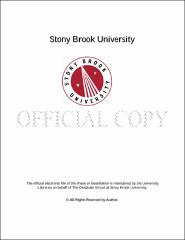| dc.identifier.uri | http://hdl.handle.net/11401/77095 | |
| dc.description.sponsorship | This work is sponsored by the Stony Brook University Graduate School in compliance with the requirements for completion of degree. | en_US |
| dc.format | Monograph | |
| dc.format.medium | Electronic Resource | en_US |
| dc.language.iso | en_US | |
| dc.publisher | The Graduate School, Stony Brook University: Stony Brook, NY. | |
| dc.type | Thesis | |
| dcterms.abstract | Depleting fossil fuel sources coupled with the deleterious effects of petroleum-based fuel combustion have led to the development of sustainable ways for energy production. One alternative is the production of biofuels like ethanol. Ethanol’s biggest advantages are its high energy density, biodegradability and carbon neutrality. A potential scalable process is the conversion of synthetic gas (syngas: CO, CO2, H2) produced from gasification of biomass with the use of Rh-based catalysts. The work presented in this thesis aimed to study the effect of the introduction of 1, 5, and 10 wt % CeO2 into a TiO2 support on Fe promoted-Rh catalysts for ethanol production from CO hydrogenation. The mixed-oxide CeO2-TiO2 support was synthesized by a sol-gel method where Rh and Fe nanoparticles were deposited by wet incipient impregnation. Reactivity studies were carried under CO hydrogenation conditions with the use of gas chromatography. Characterization of the bare support and the catalyst that showed the best ethanol selectivity were performed by in-situ X-ray diffraction synchrotron experiments. Ethanol selectivity increases with ceria content with a shift on product distribution and CO conversion rates compared to Rh supported on single TiO2 and CeO2. This could be explained by a synergetic effect between CeO2 and TiO2 and to the to the formation of amorphous and mobile species of CeOx that can act as dispersing agents for the Rh particles increasing catalytic sites for CO insertion and for the stabilization of HCOx species. XRD characterization analysis of 10%CeO2-90%TiO2 identified three crystallographic phases: anatase, TiO2(B), and cerianite. The unpromoted 2%Rh/10%CeO2-90%TiO2 in-situ XRD analysis showed an absence of Rh0 under CO hydrogenation conditions. Conversely, the addition of Fe to the different mixed-oxide compositions showed comparable ethanol selectivity at the expense of methane formation. Therefore, the introduction of ceria into the titania support on unpromoted Rh-based catalysts affects ethanol selectivity largely while when doped with Fe such effect is suppressed. | |
| dcterms.abstract | Depleting fossil fuel sources coupled with the deleterious effects of petroleum-based fuel combustion have led to the development of sustainable ways for energy production. One alternative is the production of biofuels like ethanol. Ethanol’s biggest advantages are its high energy density, biodegradability and carbon neutrality. A potential scalable process is the conversion of synthetic gas (syngas: CO, CO2, H2) produced from gasification of biomass with the use of Rh-based catalysts. The work presented in this thesis aimed to study the effect of the introduction of 1, 5, and 10 wt % CeO2 into a TiO2 support on Fe promoted-Rh catalysts for ethanol production from CO hydrogenation. The mixed-oxide CeO2-TiO2 support was synthesized by a sol-gel method where Rh and Fe nanoparticles were deposited by wet incipient impregnation. Reactivity studies were carried under CO hydrogenation conditions with the use of gas chromatography. Characterization of the bare support and the catalyst that showed the best ethanol selectivity were performed by in-situ X-ray diffraction synchrotron experiments. Ethanol selectivity increases with ceria content with a shift on product distribution and CO conversion rates compared to Rh supported on single TiO2 and CeO2. This could be explained by a synergetic effect between CeO2 and TiO2 and to the to the formation of amorphous and mobile species of CeOx that can act as dispersing agents for the Rh particles increasing catalytic sites for CO insertion and for the stabilization of HCOx species. XRD characterization analysis of 10%CeO2-90%TiO2 identified three crystallographic phases: anatase, TiO2(B), and cerianite. The unpromoted 2%Rh/10%CeO2-90%TiO2 in-situ XRD analysis showed an absence of Rh0 under CO hydrogenation conditions. Conversely, the addition of Fe to the different mixed-oxide compositions showed comparable ethanol selectivity at the expense of methane formation. Therefore, the introduction of ceria into the titania support on unpromoted Rh-based catalysts affects ethanol selectivity largely while when doped with Fe such effect is suppressed. | |
| dcterms.available | 2017-09-20T16:51:57Z | |
| dcterms.contributor | White, Michael G | en_US |
| dcterms.creator | Carrillo Sanchez, Pamela Carolina | |
| dcterms.dateAccepted | 2017-09-20T16:51:57Z | |
| dcterms.dateSubmitted | 2017-09-20T16:51:57Z | |
| dcterms.description | Department of Chemistry. | en_US |
| dcterms.extent | 62 pg. | en_US |
| dcterms.format | Application/PDF | en_US |
| dcterms.format | Monograph | |
| dcterms.identifier | http://hdl.handle.net/11401/77095 | |
| dcterms.issued | 2015-12-01 | |
| dcterms.language | en_US | |
| dcterms.provenance | Made available in DSpace on 2017-09-20T16:51:57Z (GMT). No. of bitstreams: 1
CarrilloSanchez_grad.sunysb_0771M_12475.pdf: 28005759 bytes, checksum: 3632afd1952c43790d696894162e78f8 (MD5)
Previous issue date: 1 | en |
| dcterms.publisher | The Graduate School, Stony Brook University: Stony Brook, NY. | |
| dcterms.subject | CO hydrogenation, Ethanol, Nanocatalysts, Rh-based | |
| dcterms.subject | Chemistry | |
| dcterms.title | Effect of support on iron promoted rhodium nanocatalysts for ethanol synthesis from CO hydrogenation | |
| dcterms.type | Thesis | |

